Important Guidelines for Optimizing Speed and Sensitivity in Small-Molecule LC-UV and LC-MS
LCGC North America
As LC-UV and LC-MS have become preferred instrumental methods for fast, sensitive analysis, many scientists are searching for ways to optimize performance.
The task of developing a new analytical method usually falls to someone who has at least several years of high performance liquid chromatography (HPLC) experience. Using this experience, the analyst selects appropriate instruments and columns that are likely to succeed for the analysis. A simple analysis frequently can be accomplished with C18 columns, isocratic mobile phases, and a wide variety of HPLC instrument designs. However, difficult analyses might require consideration of columns having special selectivity, use of mobile phase gradients, and very careful instrument selection.
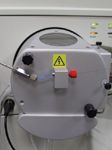
To optimize methods for maximum sensitivity (1), one should start with a detector that exhibits a high signal-to-noise ratio (S/N) for each component. When LC–UV is not adequate, sensitive techniques such as LC-mass spectrometry (MS) must be considered, or the sample must be concentrated. It is also important to keep retention factors small (k = 1–5) as long as peak resolution can be maintained. Because modern 5-μm packings routinely exhibit about 750 plates/cm (75,000 plates/m), a 5-cm column can create a rugged separation system having several thousand total plates. Such short columns often can provide adequate resolution, especially with LC–MS, if selectivity has been optimized. Small internal diameter columns can provide additional sensitivity by minimizing sample dilution when limited sample amount is available; however, excessive instrument dispersion volume can reduce efficiency and offset any sensitivity gains achieved. Finally, detector signal can be maximized by introducing the largest practical sample volume. Often, >10% of the column volume can be injected before loss of resolution is noticed (even more can be injected under gradient conditions). Column volume can be estimated from the solvent front using the relationship VM = tM F, where tM is retention time of an unretained peak and F is flow rate.
Column selectivity influences efficiency and retention requirements: The column and mobile phase are both very important and can be considered the two primary variables in HPLC method development (2). While not the main emphasis of this article, it is worthwhile to briefly examine the resolution equation (3) and the importance of the selectivity term.

Although efficiency (N) and retention factor (k) are essential elements of column performance, increased selectivity (α) allows the same resolution to be achieved with smaller N values (shorter columns) and smaller k values. Short columns and small retention factors increase separation speed and improve sensitivity. Figure 1a shows a good result with a 15-cm, C18 column. However, marginal selectivity for critical pairs 3,2 and 4,7 precludes the use of shorter columns and retention factors to improve speed and sensitivity.
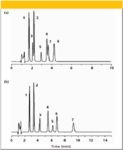
Figure 1: Separation of polar compounds on (a) C18 and (b) reversed-phase amide columns. Column: 15 cm à 4.6 mm, 5-µm Ascentis RP-Amide or C18; mobile phase: 75:25 (v/v) 20 mM phosphoric acid (pH 2.0)-acetonitrile; temperature: 30 °C; detection: UV absorbance at 270 nm; injection volume: 25 mL; sample: all components 50 µg/mL in 20 mM phosphoric acid (pH 2.0). Peaks: 1 = resorcinol, 2 = catechol, 3 =2-methyl resorcinol, 4 = 4-methyl catechol, 5 = 2,5-dimethyl resorcinol, 6 = 3-methyl catechol, 7 = 4-nitro catechol.
The same separation under identical mobile phase conditions is shown with a 15-cm, amide-type column in Figure 1b. Note that the embedded polar group has increased both retention and selectivity for this class of polar compounds. Because there is greater selectivity, fewer plates (shorter columns) would be sufficient to achieve baseline separation. The relationship between plates and selectivity can be seen by substituting typical values of RS = 1 and k = 2 into equation 1.

The dramatic impact of improving selectivity is shown in Table I. Selectivity values for the critical group of peaks 4-6 with the amide phase (calculated by the ratios k5/k4 and k6/k5) would exceed the α value of 1.1 shown in the table and require only a few thousand plates for fast, sensitive separation on a short column. This option is made possible due to greater selectivity of the amide group for the critical pairs.
A complete discussion of column and mobile phase selectivity is beyond the scope of this article. However, it should be pointed out that embedded polar group phases containing amide, carbamate, urea, and other polar groups are extremely complementary to traditional alkyl phases and often are more selective and retentive for polar compounds than alkyl, cyano, or phenyl phases. Phases showing different selectivity and elution order are said to be orthogonal for that class of compound. Neue (4) has pointed out the importance of these new embedded polar group phases and proposed a new selectivity term s2, which is derived from the correlation coefficient r2, and makes it convenient to quantitatively compare column orthogonal behavior for different classes of compounds.

Selectivity difference s2 would vary from a value of zero when two columns (or other variables such as pH) show no selectivity difference (perfect straight-line correlation or r2 equal to unity) to a value of one when two columns show completely different selectivity (no correlation or r2 equal to zero). Figure 2 confirms that the amide embedded polar group phase can be highly orthogonal to C18 (s2 = 0.55 for this group of polar compounds). Simply interchanging C18 and embedded polar group columns under the same mobile phase conditions can often improve resolution and allow the use of shorter columns. Newer versions of embedded polar group phases have been designed specifically to show very low bleed and ionic background under LC–MS conditions, allowing them to be used interchangeably with C18 or C8 during method development.
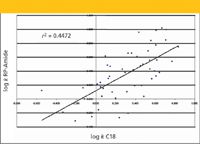
Figure 2: Typical selectivity difference plot for polar compounds with Ascentis C18 and RP-Amide phases.
Another column type that is showing increasing popularity for alternate selectivity, is the fluorinated phase, especially the perfuorophenylpropyl version. It is interesting to note that embedded polar group, perfuorophenylpropyl, and alkyl phases are often orthogonal to each other, making them a powerful method development trio for difficult separations. The early use of these three column types can ensure optimum retention and band spacing, and also confirm that all analytes and interferences have been identified. Because detectors can often limit mobile phase options, especially in LC–MS, changing columns to alter selectivity is becoming more attractive than attempting extensive changes to the mobile phase. The bottom line is that one should always use the most selective column to optimize band spacing, allow shorter columns, and produce faster, more sensitive assays.

Table I: Impact of selectivity on column requirement for Rs = 1 and k = 2
Gradient conditions: Gradient elution can be advantageous for sensitive analysis, especially when using MS and other detectors or conditions that do not show higher baseline noise and drift with changing mobile phase. Gradients avoid peak dilution that occurs with increasing k values under isocratic conditions; an optimum gradient elutes multiple components in narrow zones as though all have the same short k value. Gradients also can allow very large sample volumes to be introduced in a weak mobile phase, a sample concentration technique that has been referred to as on-column trace enrichment. When the sample contains diverse components that cannot be spaced optimally by careful column choice and isocratic conditions, programming solvent strength can optimize retention and reduce overall analysis time. Finally, gradients can keep the column and other components free of sample carryover due to trace adsorption on active surfaces.
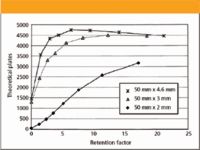
Figure 3: Plot of efficiency versus retention factor for several different columns using an eight-component mixture (9).
Of course, there are several distinct downsides to gradient elution, such as a requirement for more complex and costly instrumentation, excessive baseline drift and noise with certain detectors and conditions, and additional equilibration time between sample runs. Differences in gradient dwell volume and delay time also can make results difficult to reproduce between instruments and labs, especially at low flow rates.
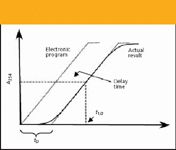
Figure 4: Illustration of how dwell volume can create a lag time between composition change at the pump and arrival at the column inlet; the actual gradient profile can be obtained by adding a UV-absorber such as acetone to the B reservoir (10).
Instrument Guidelines for Optimizing Speed and Sensitivity
Much of the effort during method development is spent trying to optimize columns and mobile phases, which are well documented in validated HPLC methods. HPLC instruments, however, are considered interchangeable, although it is well known that the same column and mobile phase conditions can produce very different results when used with different HPLC components. This is especially true when reduced-bore columns are employed to optimize sensitivity. This article will attempt to alert users to some important HPLC instrument variables that are not always considered or documented during development of an HPLC method using columns having small internal volume.
Instrument design: Majors (5) has provided a summary of the various HPLC instrument volume elements and how they can affect chromatographic performance. One important element is the volume that the sample experiences external to the column bed. It is well known that sample components spread and dilute as they travel along the column (band dispersion). However, it is not so well known that they also spread as they travel through the open channels that make up the injector and detector flow paths before and after the column. According to Bakalyar (6-8), the equations that describe these two kinds of zone spreading are

where s is the peak width standard deviation of a Gaussian distribution in volume units (estimated from width at baseline, which is about 4s). Band spreading and dilution inside the column are proportional to the volume of the column V M retention factor k, and inversely related to column plate count N. Sensitivity, therefore, is optimized with short, small internal diameter columns, low k values, and high column efficiency because they all reduce s and increase sample concentration. Band spreading and dilution in connections are influenced greatly by the diameter of the connector opening d tube, as well as length L and flow rate F. Band spreading is also inversely related to analyte diffusion coefficient D M, which means that bands related to large molecules, such as proteins, spread more rapidly than small ones under laminar flow in open channels outside of the column. This is due to slow diffusion out of the stagnant layer near the channel walls, and in this respect, causes band-broadening similar to the C-term or resistance to mass-transfer term of the Van Deemter equation inside the column.
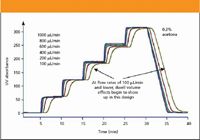
Figure 5: Step gradients with UV detection and acetone in the B reservoir to show actual gradient performance in creating solvent blends for delivery to the column (9). The chromatograms were generated with 20% step gradients to 100% after a 5-min hold.
Although the two types of band spreading have different origins, the overall effects are additive according to a variance equation

Ideally, instrument volume should be negligible. However, when the volume of the instrument becomes comparable to the volume occupied by the narrowest peak, resolution degrades rapidly. Table II shows how peak volume and other important operating parameters change as column internal diameter becomes smaller. The loss of efficiency caused by several different instrument internal volumes on a peak that is 80 μL in base width (σ = 20 μL) is shown in Table III. Peak widths in this range should be observed routinely for short columns in the 2–3 mm i.d. range with 5-μm particles. Columns having 3-μm and smaller packings will require instruments having even lower internal volumes in order to preserve column efficiency. While instrument manufacturers rarely supply data on dispersion volume, and it is challenging to measure, there is a simple experiment that can be used to calibrate and compare instruments (9). Select two or three short columns having the same phase and length, but different internal diameters (that is, 50 mm × 4.6 mm, 50 mm × 3 mm, and 50 mm × 2 mm C18 columns). Inject 20 μL of a multicomponent mixture into the 4.6-mm i.d. column at 1.25 mL/min and plot efficiency (N or N/m) versus k value, as shown in Figure 3. Use a minimum of four or five components with k values between 1 and 20 to best illustrate the effect. Repeat the experiment for the 50 mm × 3 mm column at 0.6 mL/min with a 10-μL injection, the 50 mm × 2 mm column at 0.2 mL/min with a 5-μL injection, and even smaller internal diameter columns and sample sizes if desired. Modern instruments should show very little loss of efficiency for the smaller internal diameter columns (plots should nearly overlap) down to about 50 mm × 1 mm; however, older instruments with larger internal volume will show a plot similar to that shown. Clearly, 50 mm × 2 mm columns should not be used in this particular HPLC instrument for optimum performance. This technique also can be used to maintain instruments in suitable operating condition because changes can occur in injectors, filters, and other components that can increase instrument dispersion over time. As one drops to ever smaller column internal diameters (at lower flows and smaller injection volumes), every HPLC instrument eventually will depart from the ideal of a rapid rise to constant efficiency (equal to true column efficiency) even for very short retention factors.
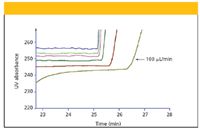
Figure 6: Blow-up of the 80% step region in Figure 5 to show effect of dwell volume when its value becomes comparable to the volumetric flow rate in mL/min (9).
Solvent delivery systems: A critical aspect of pump design is the dwell volume, which, along with flow rate, determines the time required for a gradient to arrive at the column inlet. Figure 4 illustrates the effect of excessive dwell volume, which can introduce a significant isocratic hold time when its magnitude becomes comparable to the flow rate in milliliters per minute (10). Dwell volume can be estimated from the actual gradient profile and the equation

where F is flow rate, tG is gradient duration time, and t1/2 is the time at which detector response reaches 50% amplitude. A step gradient also can be employed wheretG = 0 and the equation simplifies to FD = t1/2F; if the column is left in place for this measurement, column volume VM must be subtracted to arrive at VD. Dwell volume also impacts the equilibration time between gradient runs. Large differences in dwell volume can cause methods to translate poorly between instruments, especially at the low flows required with small internal diameter columns. An instrument with large dwell volume can take much longer to equilibrate after an isocratic change or a gradient run. Dwell volume cannot be completely eliminated in any design because solvents must be well mixed before reaching the column. However, low-pressure designs that feature prepump blending tend to have more dwell volume than high pressure designs, which use postpump blending at a mixing tee. The step gradients at several flow rates in Figures 5 and 6 show the increasing importance of dwell volume at low flows (9). Note that delay time due to dwell volume becomes noticeable in this design at 100 μL/min flow rate, which is becoming comparable to the total dwell volume of 200 μL. Although the system chosen for illustration has only 80 μL of dwell volume attributed to the pump, total dwell volume rises to about200 μL when other components such as autosampler and injector are included. Even with this rather small dwell volume, it can take a very long time at low flows for gradient arrival at the column or to change isocratic conditions during method development. Although flow splitters often are inconvenient for other reasons, the use of split flow at constant pump flow rate can eliminate excessive delay time for changes in mobile phase composition due to dwell volume.
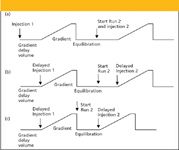
Figure 7: Using delayed sample injection to address problems caused by excessive delay time due to dwell volume (11). Shown are (a) the standard approach, (b) delayed injection alone, and(c) combined equilibration and delayed injection.
Another technique to consider when faced with a significant dwell volume effect is to invoke an injection delay that is nearly equal to the delay time due to dwell volume, as shown in Figure 7 (11). This eliminates variable retention times created by HPLC instruments having different dwell volumes. By starting a new gradient run with delayed injection immediately after completion of the previous run, as shown in Figure 7c, equilibration time and dwell volume delay time can be overlapped, cutting total delay between runs in half. These delayed injection approaches require an accurate knowledge of instrument dwell volume. Methods that involve the use of a gradient or other programmed change in solvent composition should include instrument dwell volume as part of their documentation.

Table II: Operating parameters that diminish as HPLC column i.d. becomes smaller; estimated values for 150 mm columns and 5 µm particles at k = 1
Detectors: The use of UV detectors that feature wide wavelength range and spectral output for qualitative analysis has enhanced their popularity greatly. Method development typically is carried out with UV detection in the 210–220 nm wavelength range, where most organic compounds show enough molar absorptivity for detection. UV flow cells must approach 1 cm in length in order for Beer's law to produce enough change in absorbance to allow low level detection. This is a serious limitation when reduced-bore columns are employed to minimize dilution of mass-limited samples. Flow cells can be miniaturized adequately to allow use with 1–2 mm i.d. columns, but UV detectors begin to destroy resolution when flow cell volume becomes comparable to sample zone volume.
LC–MS is much more sensitive than LC–UV when interface conditions can be optimized for mobile phase evaporation and analyte ionization. The absence of anything analogous to a UV flow cell can be a significant advantage for interfacing LC–MS to small-diameter columns. For LC–MS method development, it is especially desirable to select a few proven, volatile mobile phases and change stationary phase chemistries to optimize selectivity. A complete discussion of detector requirements for rapid, sensitive analysis is beyond the scope of this article. However, fast detector response and faster integrator sampling rate than normal is required for accurate area determination of narrow peaks.
Conclusions
HPLC with sensitive detectors is solving new problems in high speed analysis. There is still a tendency to specify C18 columns, however, even when marginal resolution prevents the use of short columns to improve speed and sensitivity. Substitution of more selective columns, containing amide or other embedded polar group phases, without changing the mobile phase can improve resolution enough to allow the use of shorter columns. When reduced-bore columns and low flow rates are used to further optimize sensitivity, HPLC instrument design can become very important. Two important aspects of an optimized instrument system are low instrument dispersion volume from injector to detector and low dwell volume in the solvent delivery system and autosampler. Even when manufacturers provide values for dispersion and dwell volume, it is useful to learn how to conduct experiments that confirm values and compare instruments. Ideally, both dispersion and dwell volumes should be documented for every HPLC instrument and referenced in method specifications when appropriate. This is becoming increasingly important as HPLC applications move toward smaller column and particle diameters.

Table III: Examples of how extracolumn dispersion can increase sample band spreading and reduce efficiency when instrument volume becomes comparable in size to column peak volume (peak volume usually is estimated by assuming base width of 4s).
Richard A. Henry is a consultant. He is retired from Penn State University, State College, Pennsylvania, where he taught instrumental analysis to chemistry majors for more than 15 years. His email address is rhenry@psualum.com.
David S. Bell is currently applications and technical support manager with Supelco, Bellefonte, Pennsylvania.
References
(1) L.R. Snyder, J.J. Kirkland, and J.L. Glajch,
Practical HPLC Method Development
, 2nd ed. (John Wiley & Sons, Hoboken, New Jersey, 1997).
(2) U.D. Neue, K.V. Tran, P.S. Iraneta, and B.A. Alden, J. Sep. Sci. 26, 1-6 (2003).
(3) R.E. Majors and P.W. Carr, LCGC 19(2), 124-162 (2001).
(4) U.D. Neue, E.S. Grumbach, J.R. Mazzeo, K.V. Tran, and D.M. Wagrowski-Diehl, "Bioanalytical Separations," in Handbook of Analytical Separations, I.D. Wilson, ed., (Elsevier Science B.V., New York, 2003).
(5) R.E. Majors, LCGC 21(12), 1124-1133 (2003).
(6) S.R. Bakalyar and K. Olsen, Rheodyne Tech. Notes 9, Rheodyne, Rohnert Park, California.
(7) S.R. Bakalyar, C. Phipps, B. Spruce, and K. Olsen, J. Chromatogr., A 762, 167—180 (1997).
(8) M.D. Foster, M.A. Arnold, J.A. Nichols, and S.R. Bakalyar, J. Chromatogr., A869, 231-241 (2000).
(9) Thermo Electron User Training Seminars, Thermo Electron Corp., Waltham, Massacusetts.
(10) Supelco User Training Seminars, Supleco, Bellefonte, Pennsylvania.
(11) Uwe D. Neue, Waters Corporation, Milford, Massachusetts, private communication.
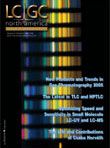
Common Challenges in Nitrosamine Analysis: An LCGC International Peer Exchange
April 15th 2025A recent roundtable discussion featuring Aloka Srinivasan of Raaha, Mayank Bhanti of the United States Pharmacopeia (USP), and Amber Burch of Purisys discussed the challenges surrounding nitrosamine analysis in pharmaceuticals.
Extracting Estrogenic Hormones Using Rotating Disk and Modified Clays
April 14th 2025University of Caldas and University of Chile researchers extracted estrogenic hormones from wastewater samples using rotating disk sorption extraction. After extraction, the concentrated analytes were measured using liquid chromatography coupled with photodiode array detection (HPLC-PDA).













